The 2010s were a decade of transformation for the St. Louis Blues franchise. The era began with the team trading their only ever first-overall pick, Erik Johnson, in a massive deal with the Colorado Avalanche. It ended with their first-ever Stanley Cup. In between, while the team was mostly successful, there was a lot of confusion, transformation, and heartbreak.
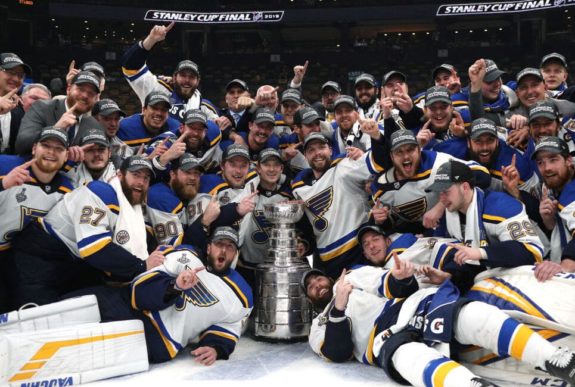
While it’s tempting to over-emphasize Stanley Cup glory in crafting the Blues’ team of the decade, it would be unfair to a franchise who qualified for the playoffs all but two of the decade’s seasons (2010-11, 2017-18). So for this list, we will prioritize impact across the decade over other factors, like postseason success, career seasons, and team role.
Without further ado, let’s look at the Blues’ team of the decade!
Management
General Manager: Doug Armstrong
Head Coach: Ken Hitchcock
It’s not difficult to choose the Blues’ general manager of the decade, as there’s been only one. Though Armstrong did not officially step into the role until July 1, 2010 (the formal end of Larry Pleau’s final season), he was already highly involved in management and is credited with the June 17, 2010, trade with the Montreal Canadiens for Jaroslav Halak, which massively transformed the team’s fortunes in net.
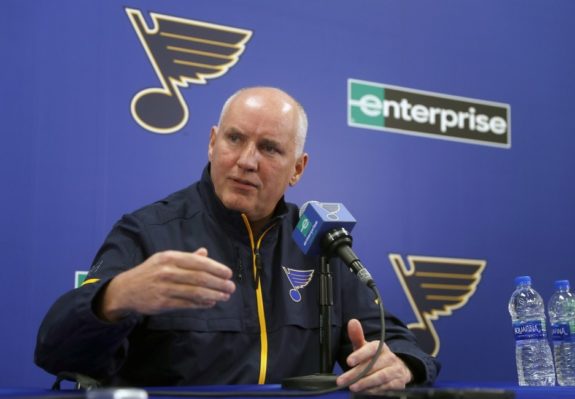
Armstrong is not only the general manager of the decade, but he is probably the greatest general manager in Blues history. He took over a team that had not won a playoff game since the 2004-05 lockout (and had only qualified once) and built them slowly and intelligently into a regular contender and eventual Stanley Cup champion. Fans have had their criticisms of Armstrong at times, but those are quiet now: he’ll have the job for as long as he wants it.
The choice of Ken Hitchcock over Craig Berube for coach of the decade will be a controversial one, but it shouldn’t be. As much as he may have been unpopular with both players and fans by the end of his tenure in St. Louis, he too took over a hapless, non-playoff team during the 2011-12 season and coached them to top contenders who made the Conference Final in his final full season at the helm.
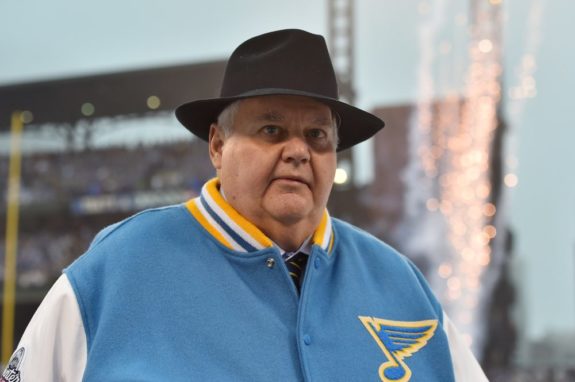
Berube took over from Hitchcock’s replacement, Mike Yeo, and, yes, steered the team to the Stanley Cup. But without Hitchcock’s foundation, it never would have been possible. Hitchcock is currently third on the all-time coaching wins list for a reason. He coached parts of six seasons this decade with St. Louis and finished with a 248-124-41 record.
Forwards
Though the Blues have been defined by their defense over the past decade, they still have had a number of fantastic offensive fixtures and guest stars. We’ll look briefly at 12 candidates, broken into four hypothetical lines.
Line 1: Alex Steen — David Backes — Vladimir Tarasenko
Alex Steen
On any list of the Blues’ most lopsided trade victories, the swap of Lee Stempniak for Alex Steen and Carlo Colaiacovo will be near or at the top. Steen is fifth all-time in games played and sixth in points for the Blues, and he’s done the bulk of that in the past decade. Much like his father Thomas before him, Alex may not be remembered as a legend of the game at large, but he is one of the truly great players in the history of a franchise and will have a home with the Blues for as long as he wants it.
David Backes
David Backes never fulfilled his dream of bringing a Stanley Cup to St. Louis, and it is one of the true tragic ironies of sports that he was in the press box for the opposing team when the team he once led first lifted the trophy. But when he retires, Backes’ time as a Boston Bruin won’t be much more than a footnote in his career.
He spent 727 games in a Blues sweater between 2006 and 2016 and spent 2011-2016 as the team’s captain. He was in the top-five of Selke Trophy voting four seasons in a row (2011-12 to 2014-15). He also helped steer the team to its best-ever finish prior to the Stanley Cup, scoring 14 points in the 2016 postseason before falling to the San Jose Sharks in the Western Conference Final. Yes, he left following that season, but only after he built an enduring legacy in St. Louis.
Vladimir Tarasenko
Vladimir Tarasenko has scored 33 goals or more in each of the last five seasons, a streak that will only end this season due to the serious shoulder injury he suffered. Even with the injury, he is sixth in goals scored since the 2014-15 season with 185 tallies in that time. Blues fans can’t overlook how truly elite a goalscorer he is.
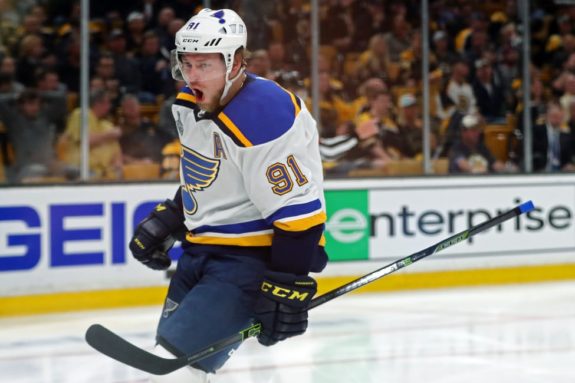
Perhaps more impressively, Tarasenko is tied for sixth in postseason goals scored for the decade, despite playing 30 or more fewer games than any of the players above him and many of the players below him. In the 2010s, he was first in goals scored per playoff game for those players who participated in 50-plus such contests. Regular season or postseason, Tarasenko is as good a scorer as anyone in the league not named Alexander Ovechkin, and he’s been the face of the Blues’ franchise for much of the last decade.
Line 2: Jaden Schwartz — Brayden Schenn — T.J. Oshie
Jaden Schwartz
Drafted two picks before Tarasenko in 2010, Jaden Schwartz hasn’t quite outshone the Russian in the last decade. He’s been better than most other forwards on the team, and had he had fewer injury issues, he might be even better-respected around the league.
Schwartz played 489 games this decade with 341 points, adding another 50 in 75 playoff games. He led the team in even-strength goals on the path to the Stanley Cup and helped significantly by adding two hat tricks during that run.
Frequently described as “the straw that stirs the drink” in St. Louis, the Blues are a palpably different team when Schwartz is unfit to compete. He has been vital to their success over the past decade.
Brayden Schenn
Schwartz and Brayden Schenn, both Saskatchewan natives, have been inseparable since the latter arrived via trade at the 2017 Draft. As such, they belong on a line in this list, though the final three centers here are difficult to rank one to three.
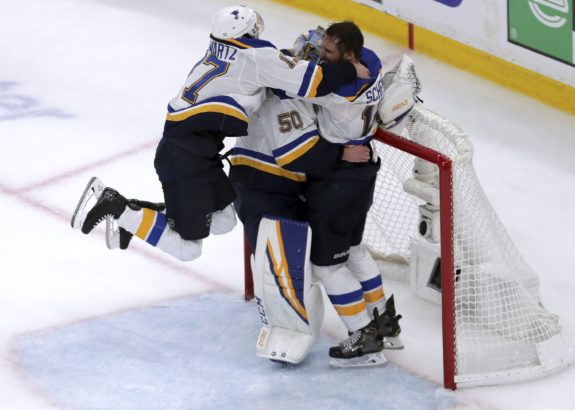
Schenn immediately set a career-high with 70 points in a full-time center role in his first season with the Blues. While 2018-19 was a bit of a disappointment for him, he seems to be back on track with 34 points in 41 games so far in 2019-20. Yes, he hasn’t played as many games as some that won’t make this list, but he’s been a top forward every second he’s spent in St. Louis, and without him, the Cup run would have been impossible.
T.J. Oshie
Whereas Steen (and others on this list) were involved in some of the very best Blues trades, T.J. Oshie was surrendered in one of the worst. Yes, Troy Brouwer scored a monumental goal for the Blues the following postseason, but he only spent that one campaign in St. Louis, while Oshie went on to further greatness with the Washington Capitals.
Personable, popular, and highly skilled, Oshie was the fresh face of the Blues’ rebuild that began to finalize at the start of the decade. He gave the Blues 443 games and 310 points and gave Blues fans, and Americans at large, a truly great Olympic memory with his legendary shootout in 2014.
Oshie is an automatic fan favorite wherever he goes, but St. Louis fans will always have to wonder what might have been. Fortunately, he won a Stanley Cup with the Capitals one season before the Blues won their first, so both parties had the happy ending they dreamed of.
Line 3: David Perron — Ryan O’Reilly — Patrik Berglund
David Perron
Few players have ever loved a team and a fanbase more than David Perron loves St. Louis. He has played with five NHL teams, and has been surrendered by St. Louis twice (once via trade, once in the Vegas expansion draft) and yet he has never signed a contract with anyone but the Blues.
Perron has played 520 games with the Blues, most in the last decade, and scored 330 points in that time. Though he’s always been skilled, he has looked like a fully evolved player since his season with the Vegas Golden Knights. Add to that that he’s formed an inseparable partnership with Ryan O’Reilly in their two shared seasons with the team, and he’s posted 86 points in 98 games since returning once again in 2018.
Ryan O’Reilly
If O’Reilly had accomplished any less in his first season and a half in St. Louis, one might object to including such a briefly tenured player on a list like this. But considering that the man the Blues acquired from the Buffalo Sabres set a career high in points in his first season with his new team, it becomes an easier pill to swallow.
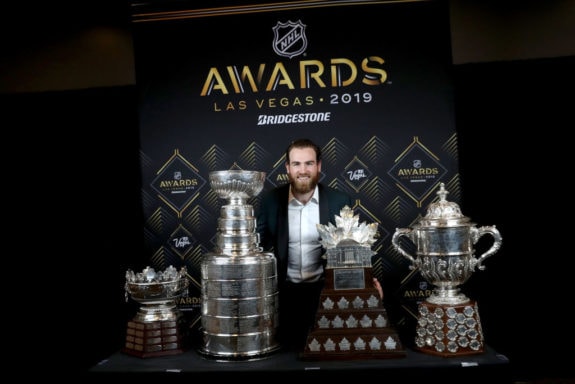
Add to that that, O’Reilly helped the team win a Stanley Cup and collected a Selke Trophy and a Conn Smythe Trophy in that first season, and the argument against becomes untenable. Blues fans would lead a revolt if O’Reilly was excluded from any list such as this. Few players have ever made such an indelible impact so quickly with a city and a team.
Patrik Berglund
Ironically, one of the players traded for O’Reilly joins him on this line. While Blues fans may have some lingering distaste for Patrik Berglund due to his production and his contract near the end of his tenure with the team, there’s no denying that he’s one of the top 12 forwards for the Blues in the 2010s.
Part of the same young core as Oshie, Perron, and Backes, Berglund played 694 games in St. Louis, scoring 322 points in that time. The “Big Swede” was a fan favorite for many years before a poorly executed contract made him persona non grata. His hockey career post-trade has taken him back to Sweden, but he may still have something to offer NHL teams in the future.
Line 4: Andy McDonald — Paul Stastny — Chris Stewart
Andy McDonald
Very few teams could avoid having a Frankenline somewhere in their all-decade team, and this is the Blues’ version. But each of these men deserves a spot nonetheless.
Andy McDonald arrived in St. Louis towards the end of their worst stretch in franchise history. He became the veteran that helped the team transition from basement-dwellers to contenders, and he helped the maturity of youngsters like Oshie, Backes, Perron, and Berglund along the way.
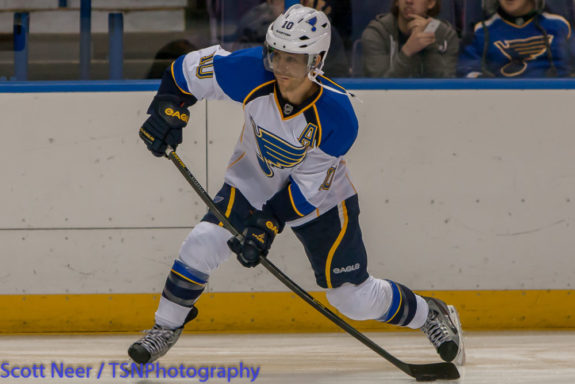
The wiry, speedy forward played 294 games with the Blues between 2007 and 2013, and he collected 230 points in that time. He added 14 points in 19 playoff games during that same period. While his impact may not feel as significant as others on this list, he lent the franchise legitimacy when it had none, and helped get the Blues back on their feet.
Paul Stastny
Hometown kid Paul Stastny may not have fulfilled the lofty expectations set for him when he signed a four-year, $28 million contract with the Blues in 2014 — ironically, those expectations would later be fulfilled by his former Colorado Avalanche teammate Ryan O’Reilly — but there’s still no question “Pauly Walnuts” deserves a place on this list.
Stastny played 267 games with the Blues, scoring 175 points. He was the team’s top center throughout that period. Ultimately, Armstrong traded him to the Winnipeg Jets for a return that included Erik Foley and the pick that became Dominik Bokk (for whom the Blues traded up), which brought an unsatisfying end to his tenure. But he was a top player throughout his time with the Blues, whether or not he lived up to the hype.
Chris Stewart
Another player who never quite fulfilled the hype, Stewart was part of the return for Johnson when Armstrong made that shocking trade in 2011. He looked like a future star immediately, scoring 15 goals and 23 points in his first 26 games with the team.
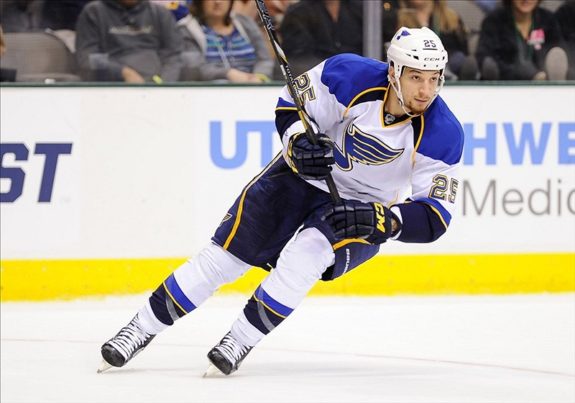
While he wouldn’t remain at that level, he played 211 games and scored 115 points, 63 of them goals. Thereafter, Armstrong traded him as part of the package to acquire Ryan Miller, meaning Stewart was part of two of the more significant trades of the decade.
Defense
As we already mentioned, the defense has been the point of pride for the Blues ever since Hitchcock took over as coach, and they’ve had a franchise centerpiece on that unit the entire decade. Their top pairing represented Canada as a unit the last time the NHL participated in the Olympics.
First Pairing: Alex Pietrangelo — Jay Bouwmeester
Alex Pietrangelo
Late in December, Alex Pietrangelo passed Al MacInnis to be the franchise leader in assists by a defenseman. It is just one of the many milestones he will set if the Blues re-sign him during or following this season. But even if they do not, he will retire as a true legend of the franchise, especially in this decade.
Pietrangelo played just 17 games before the 2010-11 season, scoring three points. Since then, he’s played in 712 games with 426 points in the regular season. He’s received votes for the Norris Trophy six times, finishing as high as fourth. He’s added 45 points in 83 playoff games as well, and this season, as team captain, he became the very first player to lift a Stanley Cup in a Blues’ sweater.
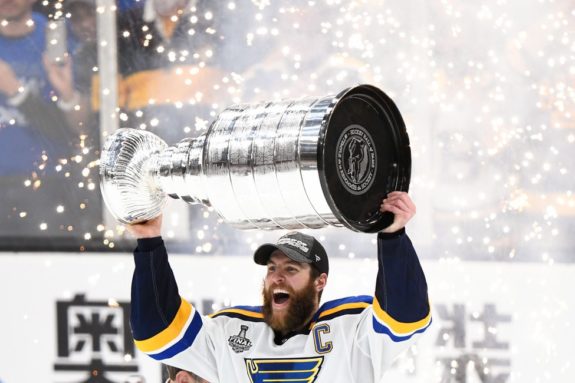
Amongst defensemen in the 2010s, Pietrangelo ranks ninth in assists (324), eighth in goals (102), and seventh in points (426). He also ranks fourth in game-winning goals, with 25. The Blues’ captain has been not only a pillar of the organization for the past 10 years, but one of the very best defensemen in the league.
Jay Bouwmeester
When Doug Armstrong acquired Jay Bouwmeester in 2013, he did it with the specific purpose of positioning the new arrival as Pietrangelo’s long-term defensive partner. And for most of the decade, they have been just that, even featuring as a tandem in the 2014 Olympics in Sochi.
Bouwmeester’s stats will never flash off the page, but there’s no debating his positioning on this all-decade squad. In 2018-19, it looked like injury may have finally taken its toll on the former NHL iron man, as his start to the season was ghastly. But he recovered, found his footing, and by the playoffs, he’d formed a shutdown defensive pairing with Colton Parayko, without which the Blues would never have captured the Stanley Cup.
Second Pairing: Kevin Shattenkirk — Barret Jackman
Kevin Shattenkirk
Kevin Shattenkirk was just starting to emerge as an offensive dynamo on the blue line when Armstrong acquired him in the Johnson trade. He proceeded to score 258 points, 131 of them on the power play, while with the Blues (425 games).
Owed a big extension and stuck behind Pietrangelo on the right side, his days in St. Louis were always numbered, and he was ultimately traded to the Capitals in 2016 for Zach Sanford and a first-round pick that the Blues later traded to acquire Schenn. He was always a fan favorite and clubhouse leader while with the Blues, though, and he certainly made his impact in the 2010s.
Barret Jackman
It’s hard to believe that way back in 2003, Barret Jackman beat out the likes of Henrik Zetterberg, Rick Nash, and even Bouwmeester for the Calder Trophy. While his career won’t be widely remembered outside of St. Louis, he is second all-time in games played for the franchise with 803.
While the bulk of those occurred in the 2000s, Jackman was still a veteran leader and an occasional contributor in the 2010s. Who could ever forget the iconic game-winning goal he scored in overtime against Corey Crawford and the rival Chicago Blackhawks in 2014?
Third Pairing: Colton Parayko — Carl Gunnarsson
Colton Parayko
Some would argue Parayko belongs above Shattenkirk on this list, and they were neck-and-neck to be sure. But it’s not an insult to rank behind Pietrangelo and Shattenkirk here.
Parayko emerged in the 2015-16 season as an absolute draft steal from the third round in 2012. The 6-foot-6 defenseman skates like the wind, has one of the hardest slapshots in the league, and he immediately became a favorite for Blues fans. Apparently, he is also a favorite of coaches, as these recent comments from Berube made clear.
With Bouwmeester, he formed a shutdown defensive pairing that was vital to the Blues’ success in 2019. At just 26, he may well have his best years ahead of him, but he’s already become an indispensable part of the franchise that drafted him.
Carl Gunnarsson
Undoubtedly, Carl Gunnarsson’s most memorable accomplishment is scoring the first-ever Stanley Cup game-winning goal in the Blues’ 52-year history. But he’s been a stabilizing presence for the defensive corps when healthy ever since arriving in exchange for Roman Polak in 2014.
Gunnarsson has played 294 games of a potential 451 since that trade, so clearly, injuries have been an issue. But when healthy, he’s been a steady defensive presence with a remarkable ability to appear on the stat sheet when it counts.
Seventh Defender: Joel Edmundson
Every team needs a solid seventh defender, and the decision between Gunnarsson and Joel Edmundson was a coin flip, so why not include him here? Edmundson was one of the Blues’ 2011 second-round picks and played 269 games for the team, including 22 en route to the Stanley Cup. He scored seven points in those playoffs.
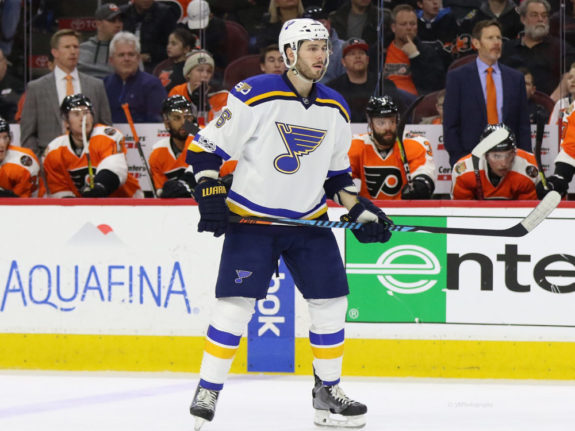
When Edmundson emerged alongside Parayko in 2015-16, fans envisioned them as the future centerpieces of the team’s blue line. And while he may never have reached that level, he is a reliable, physical presence for any team that has him. Armstrong surrendered Edmundson as part of the return for Justin Faulk prior to the 2019-20 season.
Goaltending
There’s no chance one could exclude Jordan Binnington from this list without controversy, so let’s address that at the start. Like with Hitchcock before, this list is meant to judge the player’s impact over the course of the decade. So, while Binnington has had a historically prolific debut, and helped win this team a Stanley Cup, he started just 85 games in the 2010s, including the playoffs. Hopefully, he will earn the starting role on this roster for the 2020s with ease, but there are two (and arguably three) goalies deserving of a spot in the 2010s before him.
Starter: Jake Allen
Yes, this selection will upset some Blues fans. At times, Jake Allen has been the scapegoat of the entire fanbase. And it’s true that he’s never quite seized the role of franchise goaltender like many hoped. But for the 2010s, he’s still been the team’s most significant contributor in net.
Since debuting in the 2012-13 season, he’s played 278 games for the Blues during the regular season. His career numbers are solid on paper, with a .912 save percentage (SV%) and a 2.52 goals-against average (GAA). There’s no question that he’s erratic: with heights like the 2016-17 playoff series against the Minnesota Wild, and lows like the .841 SV% and 4.05 GAA in seven games in January before that series.

Even with the inconsistency, he is a significant goalie in the history of the franchise. He is second (behind Mike Liut) in wins (143) and in shutouts (20) and third in goalie point shares (42.7). He started more games than every other Blues goalie this decade by a wide margin, and he deserves recognition here.
Backup: Brian Elliott
Don’t call him a “system goalie.” Brian Elliott’s numbers as a platoon goalie through five seasons under Hitchcock are absurd. In that time, he collected a 104-46-16 record and posted a .925 SV% and a 2.01 GAA, with 32.5 point shares. Elliott is the franchise leader in shutouts with 25, averaging five per season during his time in St. Louis. He is also the franchise leader in both SV% and GAA.
Yes, it’s easy to recognize that Hitchcock’s shutdown defensive system contributed to Elliott’s success with the Blues, especially as he’s never performed nearly as well anywhere else. But to attribute all his success to the defense around him is an insult to what “Moose” accomplished in the Gateway City. Even in departure, he helped his team, as he was traded for the pick that became Jordan Kyrou, the Blues’ current top prospect.
Prepared for 2020… And Beyond…
The 2010s were the best decade in Blues’ franchise history so far. They were competitive throughout, and their journey culminated in the first Stanley Cup in team history. Armstrong should be proud of the team he built, and the players on this roster are all a testament to his success.
But fortunately for Blues fans, their team is just getting started. At an average age of just under 28, they are slightly above the league average of 27.3. But they are loaded with young players not yet on this list who will be significant contributors to the next core of the team’s success.
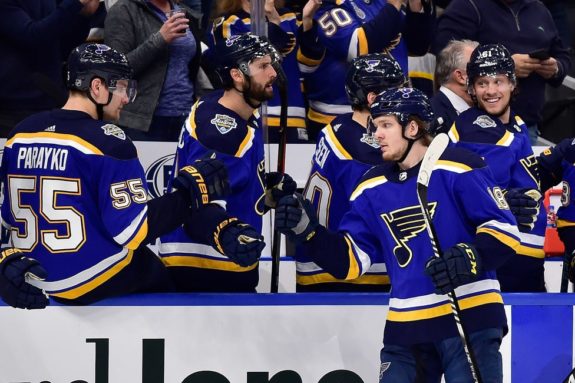
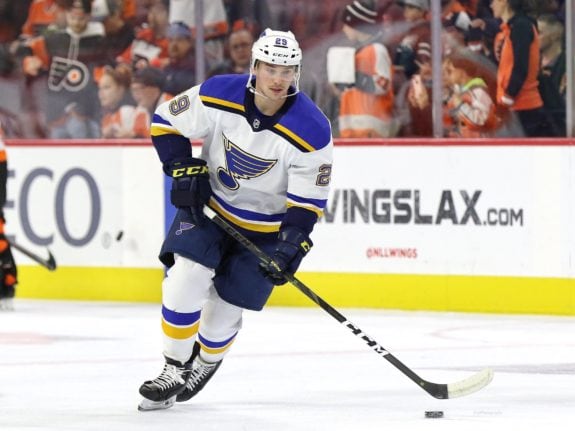
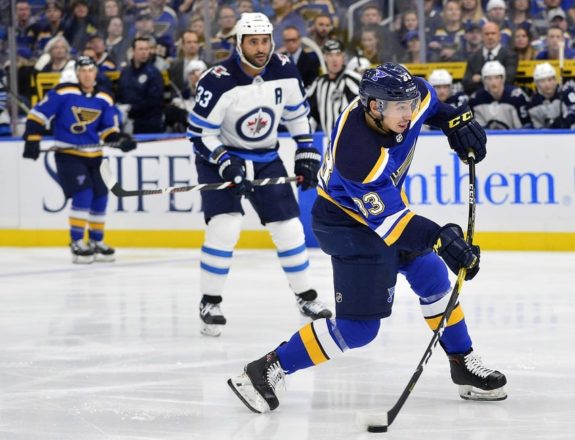
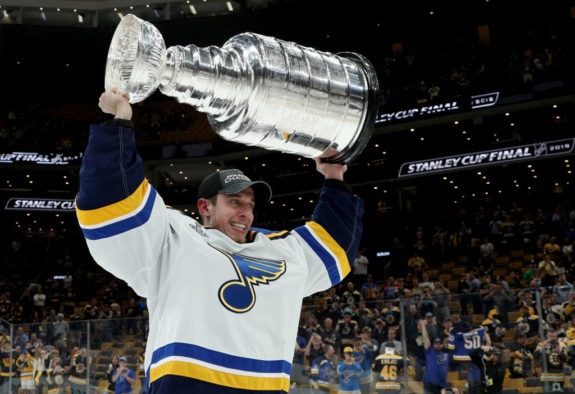
The Blues look primed to continue their success into 2020 — which they enter as the first-place team in the Western Conference — and beyond. It is a fantastic time to be a Blues fan.